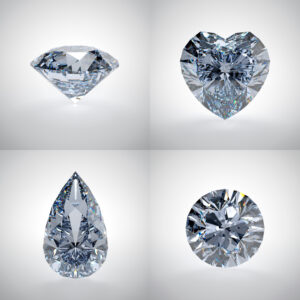
As the name suggests, man-made diamonds that closely resemble natural diamonds are known as lab-grown diamonds. They have the same physical and visual properties as real diamond crystals created by geological processes in nature because they are made up of carbon atom structures. Synthetic diamonds are normally less expensive than genuine diamonds, and lab-grown diamonds are becoming more affordable. Most millennials are now choosing lab diamonds for their engagement rings.
Lab-grown diamonds are produced by simulating the processes that produce natural diamonds. Natural diamonds are formed with the help of extreme heat and pressure, which convert carbon atoms into gorgeous and visually stunning gemstones over millions of years. Lab-grown diamonds develop in the same way as natural diamonds, but in a man-made process that takes a few weeks rather than millions of years.
How Are Lab-Grown Diamonds Created?
Diamond seeds, or small pieces of diamond, are used to create lab-grown diamonds. This seed is implanted in a special chamber that mimics the environment found deep under the Earth’s crust. The seed will start developing into a synthetic diamond that is chemically and physically identical to a natural diamond, thanks to its coating of pure carbon. High Pressure-High Temperature (HPHT) and Chemical Vapor Deposition (CVD) are the two technologies utilized to make lab-grown diamonds.
The diamond seed and the carbon atoms that coat it are subjected to extremely high heat and pressure during HPHT. CVD, on the other hand, employs a chemical gas combination that breaks down and hardens into crystalline carbon atoms rather than heat and pressure. The end outcome is the same for both methods: a man-made diamond built from the ground up in a couple of weeks.
How Is Lab-Grown Diamond Different From Natural Diamonds?

Natural diamonds and lab-grown diamonds differ not only in terms of how they’re manufactured, but also in terms of price, resale value, availability, and popularity. As we have mentioned, natural diamonds take 3-5 billion years to form. On the other hand, you can make a synthetic diamond within weeks.
Even if you’re an expert gemologist, you won’t be able to identify the difference between natural and lab-grown diamonds unless you have specialist equipment. When a professional gemologist examines the nature of the inclusions to determine if a diamond was mined or created in a lab, magnification is used. Natural diamond inclusions differ slightly from lab-grown diamond inclusions.
